If you are a big fan of cats, you probably already know that every cat breed is extraordinary in its own way, with unique traits and habits.
It’s the little things we love: squishy toe beans, tiny teeth, eyebrow whiskers, and the wild-looking ear tufts.
And if you would like to own one such wild fur baby with ear tufts, look no further than the cat breeds with ear tufts listed in this post.
Also, did you know that there is a difference between ear tufts and ear furnishings?
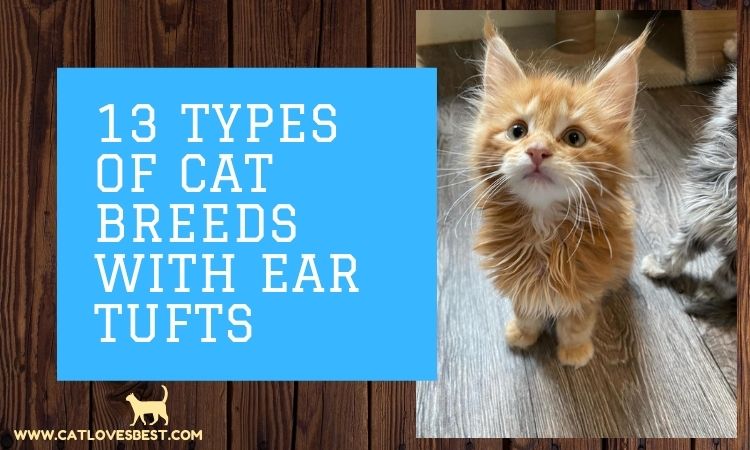
13 Different Cats With Ear Tufts
Cat ear tufts and cat ear furnishings are two different things. Cat ear tufts refer to the distinct long fur that grows on the tips of the ears, and tufts are sometimes called Lynx tips (lynx tipping). Moreover, cat ear tufts do in fact have a purpose — they work to keep debris at bay and help to filter sound directly into a cat’s ears.
Whereas cat furnishings, the scientific name for ear furs, are the hairs found in the more inside part of the cat’s ear. Cat ear furnishings do not grow from the tips.
Okay, now let’s look at some cats with ear tufts right here!
1. Norwegian Forest Cat
Together with ear tufts and ear furnishings, the topcoat with glossy, long, water-shedding hair and a woolly undercoat for protection has helped this natural cat breed to adapt to the chilly climate of Northern Europe.
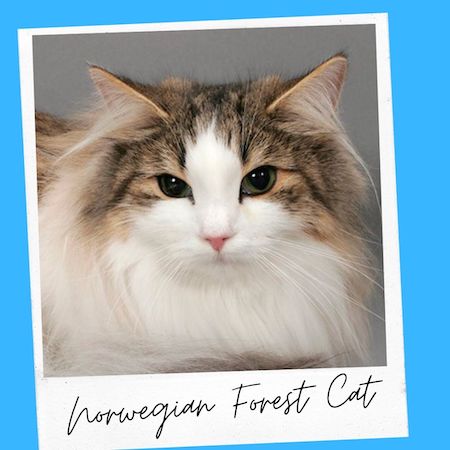
The Norwegian Forest cats are strong and large, similar to the appearance of the Maine Coon Cat with the mass of ears tufts, long legs, and fancy bushy tails, and a sturdy body. And since the breed was domesticated, the cats of this breed have become very friendly, affectionate, and intelligent. These cats love to hang out in high places.
All in all, Norwegian Forest cats are as perfect as loyal pets to stay by your side all the time.
| Height | 9–12 inches |
| Weight | 12–16 pounds |
| Pattern | Solid, Bi-color, Tabby, Calico/Tri-Color |
| Colors | Gray Lavender, Silver Cream, Beige, Tan, White Black, Ebony Red, Orange Blue |
| Intelligence | High |
2. Maine Coon
The Maine Coon cat breed is the largest domesticated breed in the world, and with the most favorable cat features, long silky coat, intelligent and affectionate personality, the Main Coon cat breed is loved by all cat lovers.
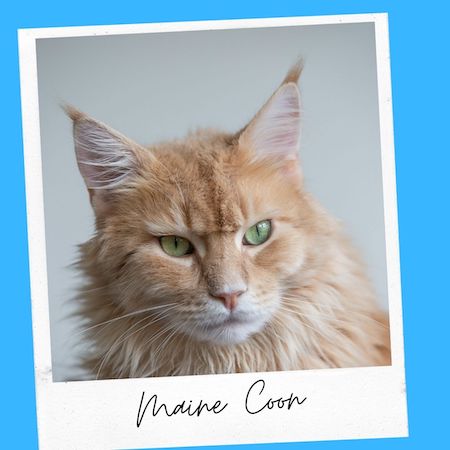
This is one of the oldest natural cat breeds in North America, particularly native to the US state — Maine. These cats are large, friendly, and outgoing, and they are often referred to as “the gentle giant.”
Maine Coons generally have both ear tufts and ear furnishings with pointy ears. The black cats of this breed look particularly magnificent with black ear tufts.
| Height | 10-16 inches |
| Weight | 8-18 pounds |
| Pattern | Bi-color, Solid, Calico/Tri-Color, Color Point, Tabby |
| Colors | White, Black/Ebony, Red/Orange, Blue/Gray, Cream/Beige/Tan, Chocolate/Brown/Sable |
| Intelligence | High |
3. LaPerm
LaPerm cats are some of the most extraordinary-looking cats in the world, thanks to their loose curls and curled ear tufts, and ear furnishings. LaPerms have a very curly coat, and the tightest of curls are present on the throat area and the base of their ears.
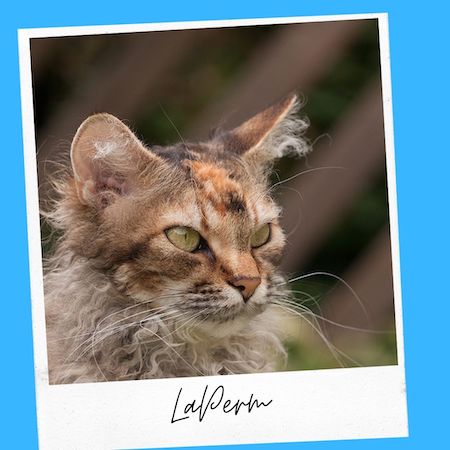
These cats are the result of the spontaneous mutation in a litter of barn kittens. LaPerms are known to have emerged in the early 1980s. This unplanned mutation was the result of Linda and Richard Koehl (breed founders) who were from The Dalles, Oregon.
They had a cat named Speedy who gave birth to a curly-coated kitten, which was then later named Curly, from whom all the LaPerm cats descend.
| Height | 6 to 10 inches |
| Weight | 8 to 10 pounds |
| Pattern | Bi-color, Solid, Tabby, Calico/Tri-Color, Color Point |
| Colors | Cream/Beige/Tan, Lilac, White, Red/Orange, Chocolate/Brown/Sable, Cinnamon, Fawn, Blue/Gray, Black/Ebony, Lavender/Silver |
| Intelligence | High |
4. Pixiebob
Pixiebobs showcase an admirable bobbed tail like the American Bobtail cats, along with adorable ear tufts. Although these cats have a unique character with a wild gazing appearance, they are surprisingly affectionate.
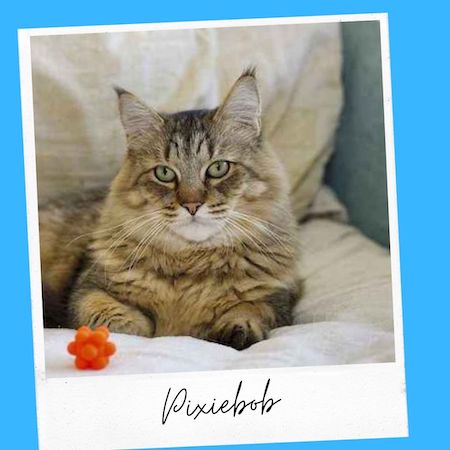
Pixie-bobs are said to be a “dog-like” breed, as they are highly intelligent, social, active, and enjoy playing with other animals. They also love “dog-like” activities, such as going on walks and playing fetch.
These cats originated by coincidental mutation, contrary to the popular belief that they descended from bobcats. And one of the coolest facts about Pixiebobs — they are often born polydactyl, or with extra toes.
| Height | 9 to 13 inches |
| Weight | 9 to 14 pounds |
| Pattern | Tabby |
| Colors | Fawn, Cinnamon, Blue/Gray, Red/Orange |
| Intelligence | High |
5. Ragdoll
Ragdoll cats are recognized for their color point coat and stunning blue eyes. These cats have a placid temperament and affectionate nature, and they love being cuddled, no matter who is holding them.
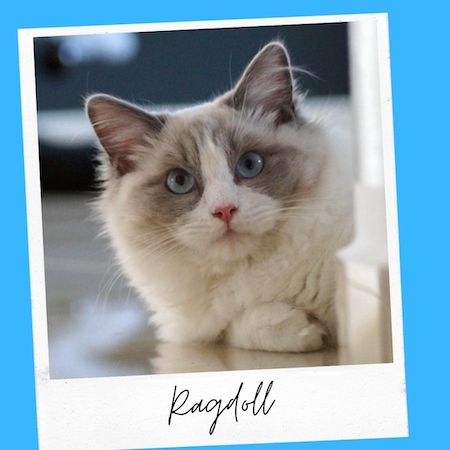
The Ragdoll cat breed was developed by an American breeder named Ann Baker around the 1960s. Further, Ragdolls have long, muscular bodies with broad chests and smaller necks and pointy ears with ear tufts.
| Height | 9-11 inches |
| Weight | 10-20 pounds |
| Pattern | Bi-Color, Color Point |
| Colors | White, Black/Ebony, Red/Orange, Blue/Gray, Lavender/Silver, Cream/Beige/Tan, Chocolate/Brown/Sable, Lilac |
| Intelligence | High |
6. Siberian
The Siberian cats are a naturally occurring domestic cat breed that is usually seen in Russian. They are also called by other names such as Siberian Forest cats, and they vary from medium to medium-large in overall size.
Siberian cats are known to be affectionate, and they are very attached to their owners and follow them around the house. Besides, Siberian cats are one of the oldest cat breeds in existence, with references going back to a thousand years around their homeland of Russia.
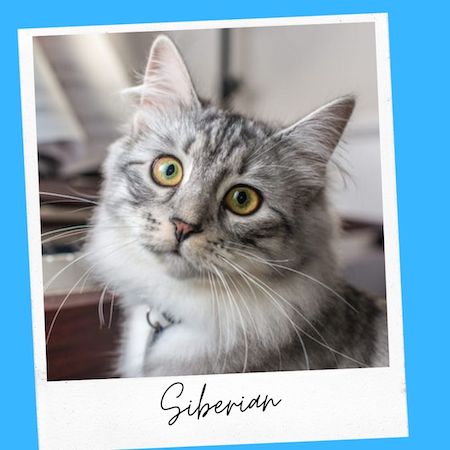
The ears of Siberian cats seem to have rounded edges, but that is not true. However, they appear pointy due to the long ear tufts. In addition to their ear tufts and ear furnishings, the Siberian cats have a long, thick coat.
Although the coats of these cats are found in many colors and patterns, the brown tabbies appear to be the most common ones.
| Height | 10–12 inches |
| Weight | 12–15 pounds |
| Pattern | Shaded Tabby, Mackerel, Classic (Blothced) |
| Colors | White, Black/Ebony, Red/Orange, Blue/Gray, Lavender/Silver, Cream/Beige/Tan, Chocolate/Brown/Sable, Lilac, Fawn |
| Intelligence | High |
7. Turkish Van
The Turkish Van cat breed is known to have originated in the mountains of modern-day Turkey. The cats from this breed have semi-long hair. In fact, they have two different lengths of hair depending on the time of the season.
During the time of the winter, a Turkish Van cat would have thick and long hair. And during the time of summer, these cats shed their hair and this leaves a short, light coat. As for the cat’s ears, Turkish Van cats have brown, black, gray, and red ears that are usually the same color as their tail.
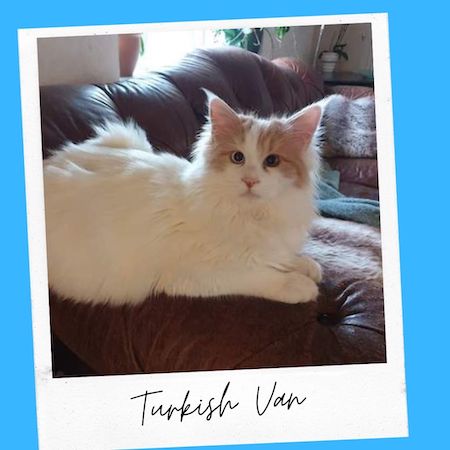
Moreover, these cats have ear tufts and ear furnishings. And one of the strange but cool things about these cats is that they are known for their love of water. Turkish Van cats are some of the oldest cat breeds in existence and are excellent swimmers.
| Height | 10 -14 inches |
| Weight | 10-20 pounds |
| Pattern | Solid |
| Colors | White |
| Intelligence | High |
8. American Curl
The American Curl cats are typically known for their unusual type of ears that curl back from the face to the center of the back of the cat’s skull. These cats have very sensitive ears, so their ears should be handled with proper care, as rough handling can cause harm to the ear cartilage.
These cats have both ear tufts and ear furnishings and require frequent cleaning to prevent infections. Likewise, American Curls are a relatively young cat breed that is pretty active, affectionate toward cat owners, and intelligent.
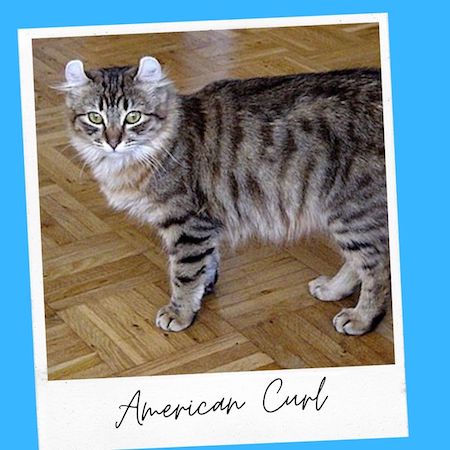
A pet quality American Curl may have nearly straight ears. However, show cats need to have ears that curl in an arc that is between 90 and 180 degrees.
| Height | 9-12 inches |
| Weight | 5-10 pounds |
| Pattern | Bi-color, Solid, Calico/Tri-Color, Color Point, Tabby |
| Colors | Chocolate/Brown/Sable, Cinnamon, Lavender/Silver, Fawn, Blue/Gray, Black/Ebony, Cream/Beige/Tan, Lilac, Red/Orange, White |
| Intelligence | Medium |
9. Nebelung
The Nebelung cats are marked by their long, slender neck, long legs, long or medium coat, and long tail. These cats have slightly oval eyes which are usually of vivid green color, or sometimes yellow-green. And one of the surprising things about these cats is that they can live longer than 16 years on average.
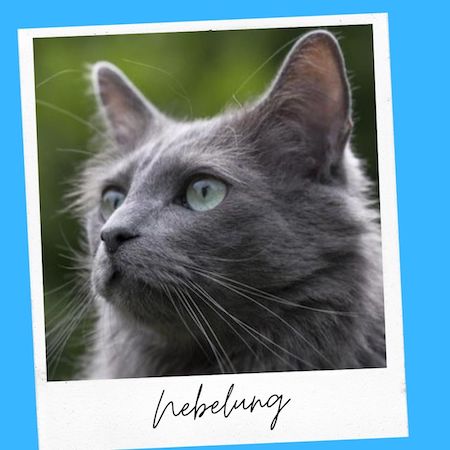
These gray beauts have impressive ear tufts and ear furnishings. Moreover, these cats are often explained as a long-haired version of the domestic short-hair Russian Blue cats, which is false. In fact, Nebelung is an extraordinary pedigree breed of domestic cat, named after the German saga — Nibelungenlied.[1]
| Height | 9-13 inches |
| Weight | 7-15 pounds |
| Pattern | Solid |
| Colors | Blue/Gray |
| Intelligence | Medium |
10. Serval
The Serval cats are wild and are native to Africa. With a body size no bigger than a medium-sized dog, some people keep these cats as a pet. However, they don’t make the best pet cat, as this cat breed is not domesticated by humans.
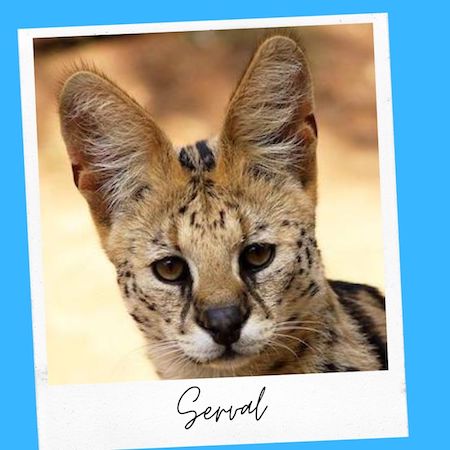
One of the distinct features of these cats is their jumbo ears, just like their long legs. These cats are known to jump as high as 12 ft to catch birds in mid-air. Moreover, they have large ears, and they are sometimes referred to as “radar dishes” to locate food in the wild.
Serval cats can pretty much hear even the smaller chirp on the savanna. They are known to use their ears more than their eyes. Likewise, the ear tufts are just another great additional feature to these energetic wild cats.
| Height | 21–24 inches |
| Weight | 24-28 pounds |
| Pattern | Spotted |
| Colors | Gold |
| Intelligence | High |
11. Caracal
Here’s another wild cat that is native to Africa and some parts of Asia. These cats are characterized by a sturdy build, extended legs, a small face, long tufted ears, and long canine teeth.
These types of cats are usually seen in the wild, and they mainly live alone, or they can be found in pairs. Moreover, they are mainly a nocturnal kind and are secretive and hard to find. And similar to the serval cats, caracal cats can also jump up to a height range of 12ft.
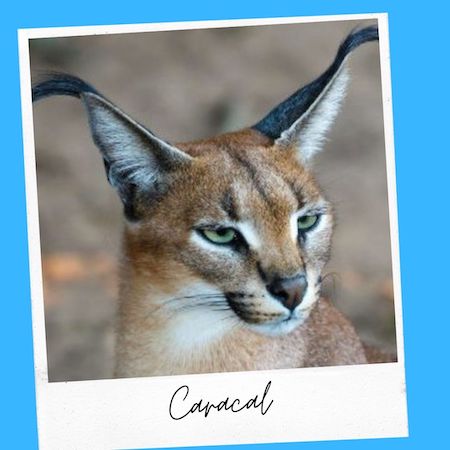
It is known that these wild cats use their elongated tufted ears to communicate with other caracals. It is especially essential for these solitary cats during the mating seasons.
| Height | 16–20 inches |
| Weight | 24-28 pounds |
| Pattern | Solid |
| Colors | Gold |
| Intelligence | High |
12. American Bobtail
The American Bobtails are usually found in medium to large sizes, and they have a naturally occurring bobbed tail. Further, their tails, tufted ears, and robust body make the American Bobtail give out a distinctive wild appearance with a natural hunting gaze.
This large cat breed is relatively modern, it is said to be developed in the late 1960s. The cat’s coat can be found in any pattern, such as black, brown, chocolate, cinnamon, blue, lilac, fawn, red, and cream, with or without white.
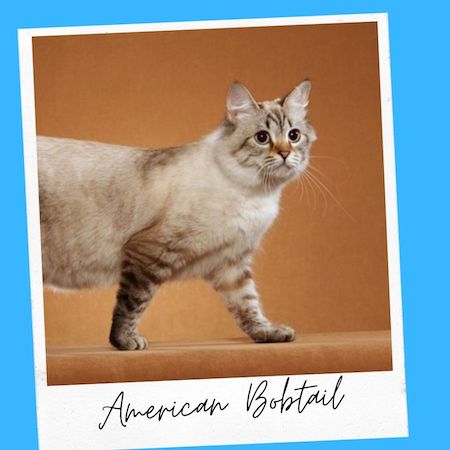
They are also short-hair and long-hair coat variants, which are rather shaggy than dense or fluffy. The overall foundation of American Bobtail lies in feral domestic cats that had natural bobtails.
The evolution of the breed started in the late 1960s, when — the breed founders — John and Brenda Sanders, were holidaying around the American southwest. When they came back home, they brought a brown tabby kitten with a short tail, whom they found during their journey.
This brown tabby kitten later mated with the founder’s non-pedigreed domestic color point cat. The result was a kitten that inherited the distinctive short tail and caught the eye of many cat fanciers, who saw the chance of a new breed of cats.
| Height | 9-10 inches |
| Weight | 7-16 pounds |
| Pattern | Bi-color, Solid, Tabby, Calico/Tri-Color, Color Point |
| Colors | Chocolate/Brown/Sable, Cinnamon, Lavender/Silver, Fawn, Blue/Gray, Black/Ebony, Cream/Beige/Tan, Lilac, Red/Orange, White |
| Intelligence | High |
13. Persian
If you are a big cat fan, then you may have already heard the name of the cat breed — Persian cats. The cats of this breed are somewhat blessed and cursed in terms of their unique appearance.
They have a big, flat, snub-nosed face appearance with a thick, double silky coat which makes this breed so famous. Persian cats are usually seen with fuzzy ear tufts and ear furnishings.
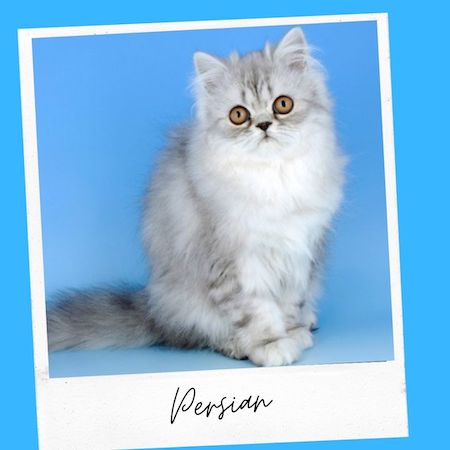
Moreover, these cats are referred to as “furniture with fur” due to their long periods of inactivity and lethargicness. However, Persian cats are sweet, gentle-mannered, affectionate, and love to be groomed. But grooming can be quite a challenge.
And since Persian cats have smaller and fuzzier ears compared to most cat breeds, so it’s easy for ear infections to go unseen or untreated. These cats are known to have an average lifespan of 12–17 human years.
| Height | 10-15 inches |
| Weight | 7-13 pounds |
| Pattern | Solid, Bi-color, Tabby, Calico/Tri-Color, Color Point |
| Colors | White, Black/Ebony, Red/Orange, Blue/Gray, Lavender/Silver, Cream/Beige/Tan, Chocolate/Brown/Sable, Cinnamon, Fawn, Lilac |
| Intelligence | Medium |
Bottom Line
And there you have it, folks! Thirteen types of unique cat breeds with ear tufts. We can all agree that those wild-looking ear tufts just add more cuteness to these furry creatures.
Cats are known to have ear tufts, but there are two types of cats with ear tufts. The first type has one tuft on each ear, while the second type has one tuft on each side of the head.
Whether it is the cat’s personality, boldness, feline traits, or silky coat, any cat with ear tufts and ear furnishings never ceases to amaze and delight cat lovers.
References
- What kinds of cat have long hair & ear tufts? — The Nest
- Cats with ear tufts & cat ear furnishings — Litter Robot
- The amazing ears of the Caracal — Wild Cat Conservation

